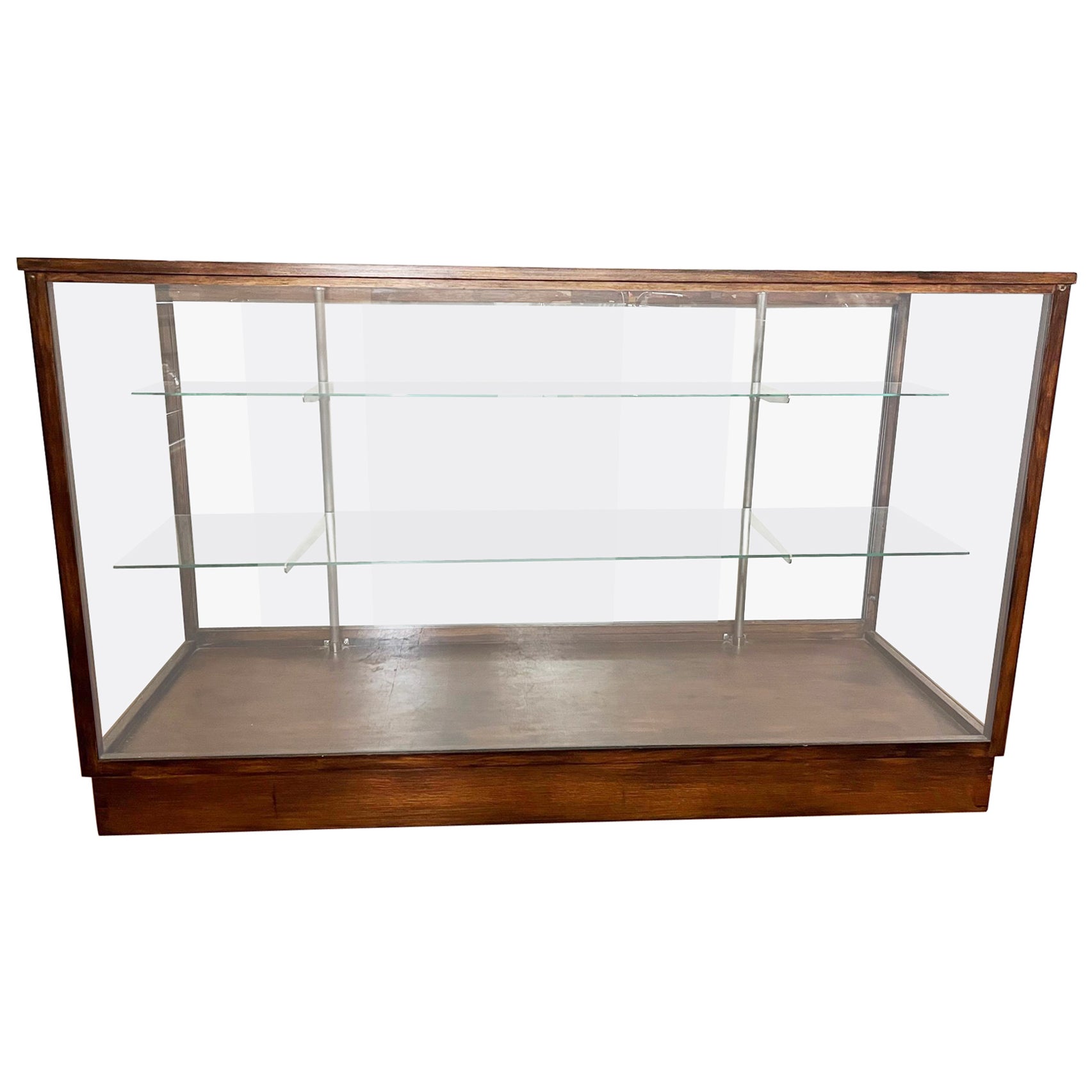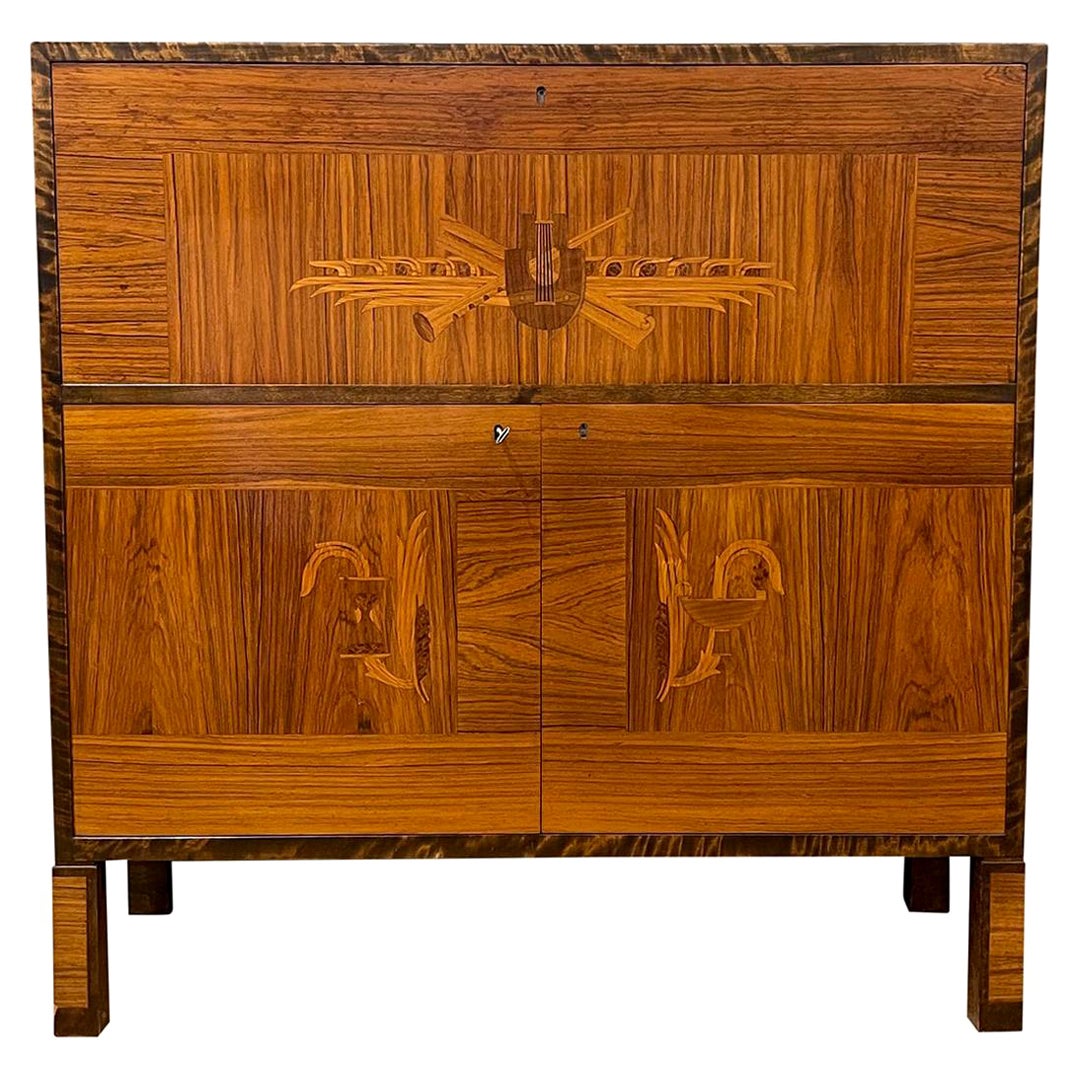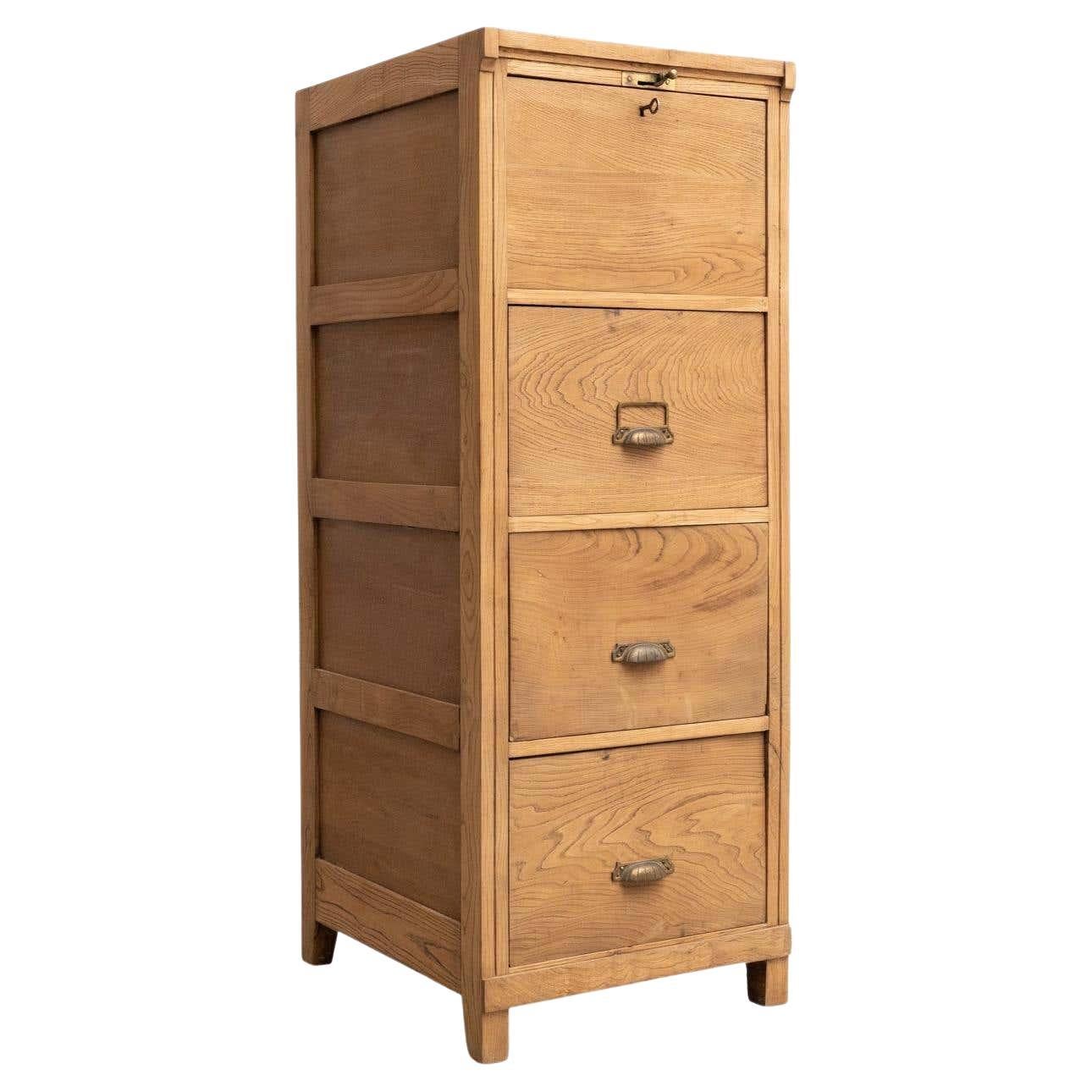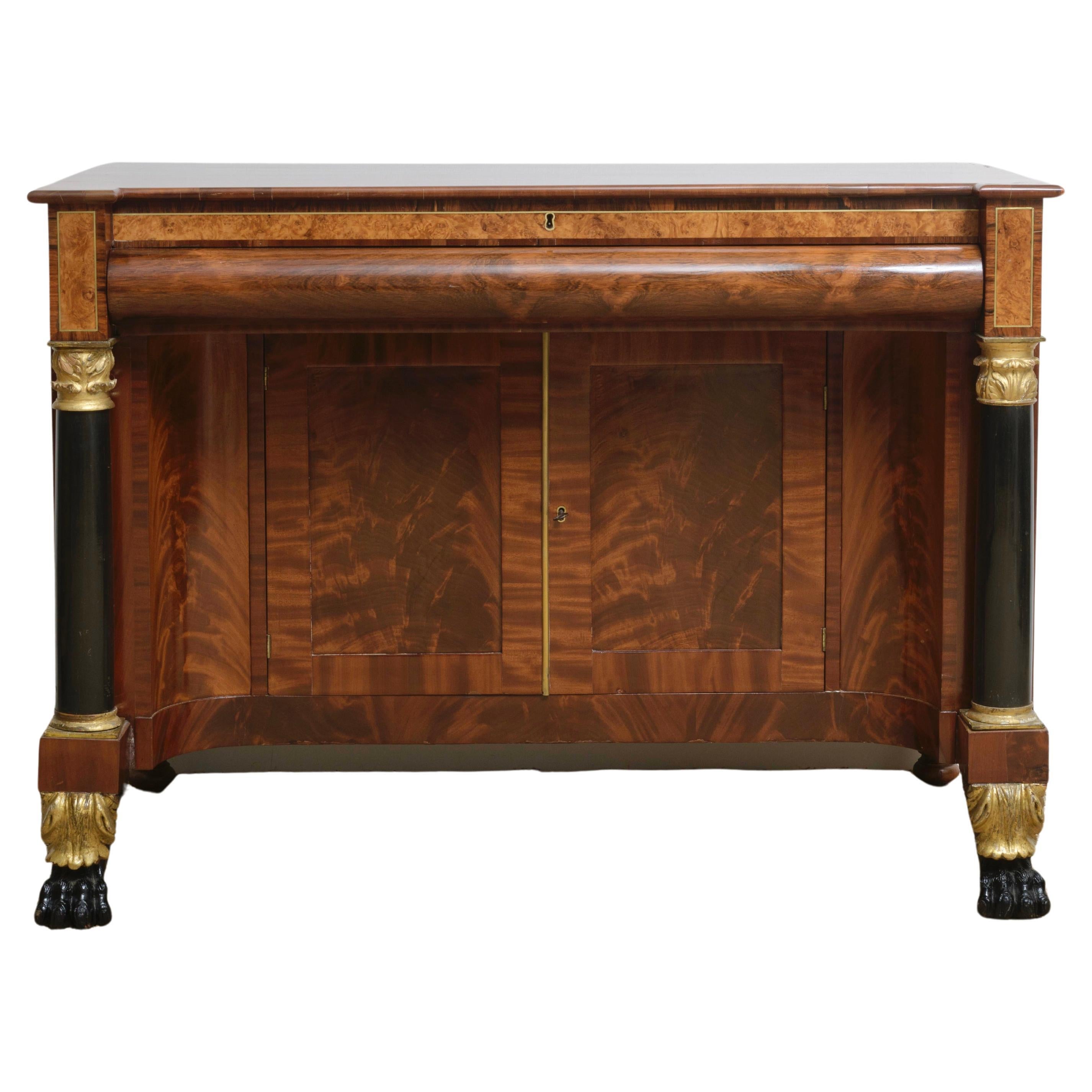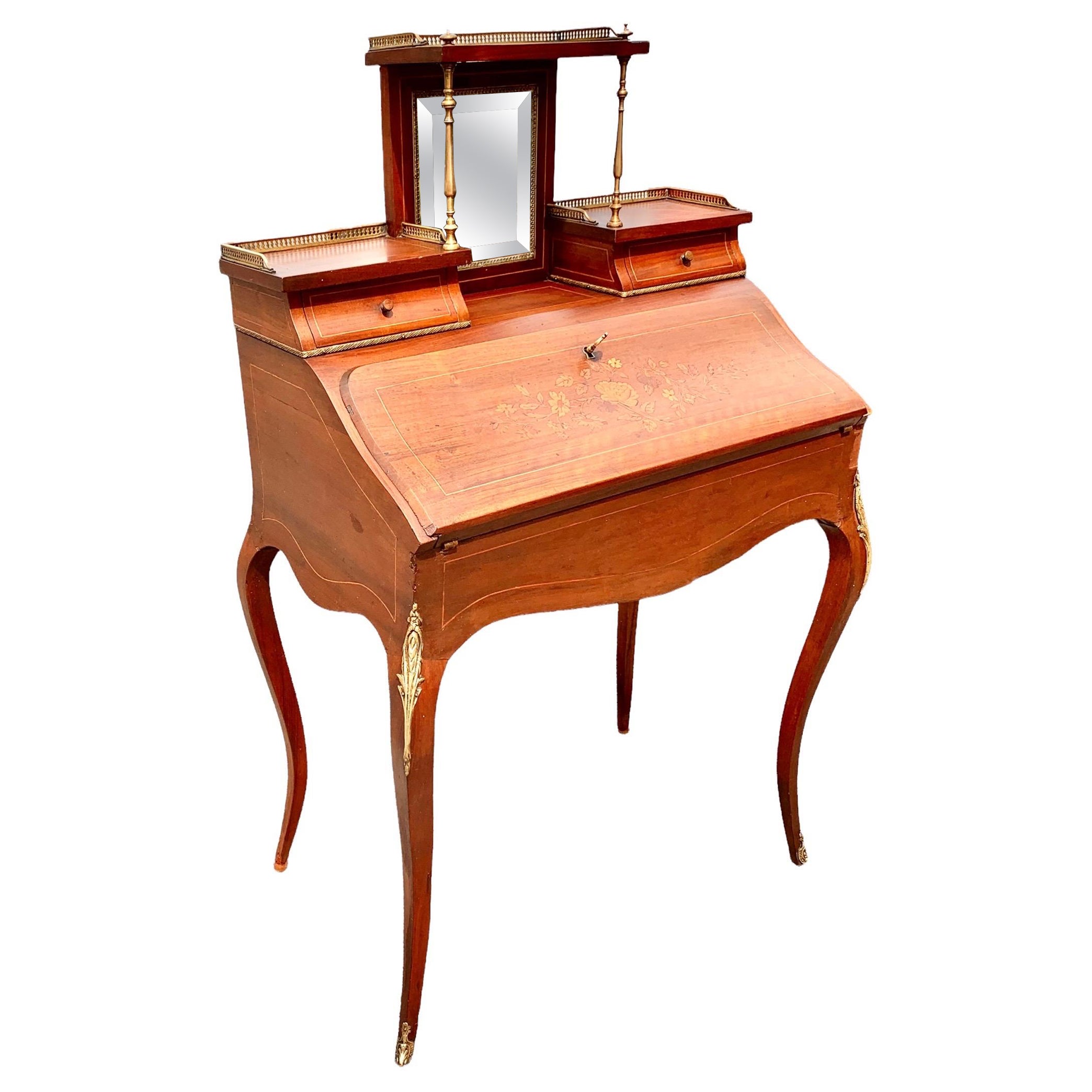Items Similar to 19th C Antique Military Campaign English Traveling Writing Desk Tompson Patent
Want more images or videos?
Request additional images or videos from the seller
1 of 15
19th C Antique Military Campaign English Traveling Writing Desk Tompson Patent
About the Item
An antique, circa mid 19th Century English Military Campaign traveling writing or lap desk with brass details, a fitted leather and gilt interior, two ink bottles, pen tray and compartments under the fold out writing area. The campaign desk features an ornate brass escutcheon on the top lid engraved with the date 1870 and the name R. Gerrard. The lock escutcheon on the front features a highly detailed image of a lion and a unicorn - symbols of the United Kingdom. The manufacturer's name is also on the escutcheon, Tompson. The blue and gilt leather interior appears newer than the desk. There are two glass (possibly crystal) and brass capped bottles presumably for ink that look to be original to the desk. The recessed brass handles on either side, fit neatly into their surrounds. When closed the desk measures 20" wide by 6.75" high by 10.5" deep. Some of the inlaid brass detailing has lifted slightly from one corner on the top of the box and there is also an age crack. A brief description of campaign furniture: "Any furniture specifically made to break down or fold for ease of travel can be described as campaign furniture. It was designed to be packed up and carried on the march. It has been used by traveling armies since at least the time of Julius Caesar but it is commonly associated with British Army officers, many of whom had purchased their commissions. With the rise and expansion of the British Empire in the 19th and 20th centuries the demand by the military, administrators and colonists increased. British officers of high social position in the Georgian and Victorian periods (1714–1901) often carried high-quality portable furniture."
- Dimensions:Height: 15.5 in (39.37 cm)Width: 20 in (50.8 cm)Depth: 19.5 in (49.53 cm)
- Style:Campaign (Of the Period)
- Materials and Techniques:
- Place of Origin:
- Period:
- Date of Manufacture:1850's
- Condition:Replacements made: The leather interior appears replaced. Wear consistent with age and use. In fair to good antique condition with age appropriate wear. Cracks, some lifting of the brass inlay are evident.
- Seller Location:Atlanta, GA
- Reference Number:1stDibs: LU7240237945232
About the Seller
5.0
Vetted Seller
These experienced sellers undergo a comprehensive evaluation by our team of in-house experts.
Established in 2002
1stDibs seller since 2022
62 sales on 1stDibs
Typical response time: <1 hour
- ShippingRetrieving quote...Ships From: Atlanta, GA
- Return PolicyThis item cannot be returned.
Auctions on 1stDibs
Our timed auctions are an opportunity to bid on extraordinary design. We do not charge a Buyer's Premium and shipping is facilitated by 1stDibs and/or the seller. Plus, all auction purchases are covered by our comprehensive Buyer Protection. Learn More
More From This SellerView All
- 19th C English Print by H. Strafford of Three South Down Wethers Kulicke FrameBy Robert KulickeLocated in Atlanta, GAThis is where the antique mixes with the modern. Where worlds collide and give rise to something fresh, new and unique. A mid 19th century British print by Henry Strafford presented ...Category
Antique Mid-19th Century English Prints
MaterialsMetal
- 19th Century English Tinsel Print Portrait of Actor Retailed Saxon and ClemensLocated in Atlanta, GAA mid 19th century English full length portrait tinsel print hand colored and hand embellished, framed and retailed by Saxon and Clemens of New York City (original paper backing has been lost to time, however this print is similar to two others both from Saxon and Clemens) circa mid 20th century. This print depicts, "Mr. Collins as Sir Reginold the Bold in the Giant of Palestine". This is one of three tinsel prints that I have available on my HKFA storefront here on 1stdibs. From the Robertson Davies Collection website, I would like to share with you this fascinating history of tinsel prints, "As the popularity of these prints became wide spread, bags of prepared tinsel decorations were sold along with the prints making them customizable by the purchaser. Thus after the tinseling process, no two prints would be identical. Tinsel prints emerged from the tradition of toy theatres. Once an appropriate model theatre was purchased, the public could buy prints depicting actors, actresses and scenery from plays that were being performed at the time and recreate those plays in their home. As the "juvenile drama" became popular, play books were published along side prints so the words of the plays could be recreated as well. While the genre flourished the desire to purchase a larger print of a specific actor or actress remained. Thus two types of theatrical prints became to be printed: those for juvenile dramas that were small and excluded specific actors names, and actors portraits that were larger and more individualized. In the larger theatrical portraits, characters were "always displayed full length" and "striking [a] habitual and dramatic pose". The 1830's marked the emergence of tinseling prints as a past time. Before this time, if an individual wished to embellish a portrait, individual sheets of metal foil would have to be purchased, measured and cut to fit an individual print. Once tinseling became common, different packages of precut tinsel (specific to the print)would be sold with each print as aforementioned. The term tinsel specifically refers to the metal sheets used to represent armor and weapons, but more broadly includes pieces of satin, silk, velvet, leather, and feathers among other embellishments. Although tinsel prints are now viewed as works of art, in the nineteenth century they were no more than a child's pastime. Most sources cite tinseling, as well as toy theatre, as being most popular among boys from the working class. Their popularity among boys could explain why male portraits were produced more frequently than female, however, it is more likely that male costumes, with their multiple pieces of armor and arms...Category
Antique Mid-19th Century English Prints
MaterialsFoil, Brass, Metal
- 19th Century English Tinsel Print Portrait of Actor Retailed Saxon and ClemensLocated in Atlanta, GAA mid 19th century English full length portrait tinsel print hand colored and hand embellished, framed and retailed by Saxon and Clemens of New York City circa mid 20th century. This print depicts, "Mr. Freer as Marmion". This is one of three tinsel prints that I have available on my HKFA storefront here on 1stdibs. From the Robertson Davies Collection website, I would like to share with you this fascinating history of tinsel prints, "As the popularity of these prints became wide spread, bags of prepared tinsel decorations were sold along with the prints making them customizable by the purchaser. Thus after the tinseling process, no two prints would be identical. Tinsel prints emerged from the tradition of toy theatres. Once an appropriate model theatre was purchased, the public could buy prints depicting actors, actresses and scenery from plays that were being performed at the time and recreate those plays in their home. As the "juvenile drama" became popular, play books were published along side prints so the words of the plays could be recreated as well. While the genre flourished the desire to purchase a larger print of a specific actor or actress remained. Thus two types of theatrical prints became to be printed: those for juvenile dramas that were small and excluded specific actors names, and actors portraits that were larger and more individualized. In the larger theatrical portraits, characters were "always displayed full length" and "striking [a] habitual and dramatic pose". The 1830's marked the emergence of tinseling prints as a past time. Before this time, if an individual wished to embellish a portrait, individual sheets of metal foil would have to be purchased, measured and cut to fit an individual print. Once tinseling became common, different packages of precut tinsel (specific to the print)would be sold with each print as aforementioned. The term tinsel specifically refers to the metal sheets used to represent armor and weapons, but more broadly includes pieces of satin, silk, velvet, leather, and feathers among other embellishments. Although tinsel prints are now viewed as works of art, in the nineteenth century they were no more than a child's pastime. Most sources cite tinseling, as well as toy theatre, as being most popular among boys from the working class. Their popularity among boys could explain why male portraits were produced more frequently than female, however, it is more likely that male costumes, with their multiple pieces of armor and arms...Category
Antique Mid-19th Century English Prints
MaterialsMetal, Brass, Foil
- 19th Century English Tinsel Print Portrait of Actor Retailed Saxon and ClemensLocated in Atlanta, GAA mid 19th century English full length portrait tinsel print hand colored and hand embellished, framed and retailed by Saxon and Clemens of New York City circa mid 20th century. This print depicts, "Mr. Freer as Alonzo the Patriot". This is one of three tinsel prints that I have available on my HKFA storefront here on 1stdibs. From the Robertson Davies Collection website, I would like to share with you this fascinating history of tinsel prints, "As the popularity of these prints became wide spread, bags of prepared tinsel decorations were sold along with the prints making them customizable by the purchaser. Thus after the tinseling process, no two prints would be identical. Tinsel prints emerged from the tradition of toy theatres. Once an appropriate model theatre was purchased, the public could buy prints depicting actors, actresses and scenery from plays that were being performed at the time and recreate those plays in their home. As the "juvenile drama" became popular, play books were published along side prints so the words of the plays could be recreated as well. While the genre flourished the desire to purchase a larger print of a specific actor or actress remained. Thus two types of theatrical prints became to be printed: those for juvenile dramas that were small and excluded specific actors names, and actors portraits that were larger and more individualized. In the larger theatrical portraits, characters were "always displayed full length" and "striking [a] habitual and dramatic pose". The 1830's marked the emergence of tinseling prints as a past time. Before this time, if an individual wished to embellish a portrait, individual sheets of metal foil would have to be purchased, measured and cut to fit an individual print. Once tinseling became common, different packages of precut tinsel (specific to the print)would be sold with each print as aforementioned. The term tinsel specifically refers to the metal sheets used to represent armor and weapons, but more broadly includes pieces of satin, silk, velvet, leather, and feathers among other embellishments. Although tinsel prints are now viewed as works of art, in the nineteenth century they were no more than a child's pastime. Most sources cite tinseling, as well as toy theatre, as being most popular among boys from the working class. Their popularity among boys could explain why male portraits were produced more frequently than female, however, it is more likely that male costumes, with their multiple pieces of armor and arms...Category
Antique Mid-19th Century English Prints
MaterialsBrass, Foil
- Antique French Gilt and Carved 19th Century Cane Upholstered Bergere ArmchairLocated in Atlanta, GAAn antique, mid to late 19th century French cane and upholstered carved and gilt armchair. The armchair features carved and gilt floral swags around the caned back, running coin orna...Category
Antique Late 19th Century French Louis XVI Chairs
MaterialsUpholstery, Cane, Wood, Giltwood
- 19th Century Antique French Neoclassical Style Drawing Picture Frame 15 x 12Located in Atlanta, GAA beautiful and antique late 19th century circa 1880's French Neo-Classical style picture frame, mostly associated with drawings or works on paper. The rabbet size (size that holds t...Category
Antique Late 19th Century French Neoclassical Picture Frames
MaterialsGold Leaf
You May Also Like
- 19th C. English Campaign Style Mahogany Travel Desk by G. Riddle, LondonLocated in Bridgeport, CTA finely crafted travel desk by a noted British maker of boxes. The campaign style box has shaped brass corners, tabs, a lid plaque, center front escutcheon, and classic encased side...Category
Antique 19th Century English Campaign Decorative Boxes
MaterialsBrass
- Mid 19th century burr campaign lap writing deskLocated in Debenham, SuffolkMid 19th century burr campaign lap desk circa 1860. Good quality burr writing box. Beautifully brass bound outside and inside edging. Stunning burr wood exterior. Original dark blu...Category
Antique Mid-19th Century Burmese Campaign Desks
MaterialsBrass
- Exquisite Antique Hardwood Military Campaign Writing Slope Desk & Later StandLocated in GBWe are delighted to offer for sale this absolutely stunning original Antique Victorian Mahogany & Brass Military Campaign writing slope. I actually have a pair of these, the other has slightly different dimensions and is listed under my other items. What a find, if you are in the market for this type of luxury antique militaria...Category
Antique 19th Century English Campaign Desks
MaterialsBrass
- Antique English 19th Century Oak Writing DeskLocated in New Orleans, LAAntique 19th century handsome oak writing desk.Category
Antique 19th Century English Jacobean Desks
MaterialsOak
- Exquisite Victorian Hardwood Military Campaign Writing Slope Desk & Later StandLocated in GBWe are delighted to offer for sale this absolutely stunning original Antique Victorian Mahogany & Brass Military Campaign writing slope with later stand What a find, if you are in the market for this type of luxury antique militaria then look no further, this is the finest example I have personally seen. The timber patina is glorious, it’s a very old type of mahogany, most likely Cuban. The brass fixtures and fittings all operate perfectly and are flawlessly mounted The stand has been made at a later date to showcase and protect the piece, it is now the size of a normal side table. The writing slope itself has some interesting features, the top can be sat at a 45 degree angle for reading, there is a piece of beaded wood that slots into the two front holes, this holds and seats whatever literature you wish to rest there. The large side drawer is locked in place by a long metal rod, this rod also stops the drawer from coming all the way out. You have two internal document storage sections and various stationary cubby’s. The writing slope is baize lined and on the underside of the base you have a crosshatched silk ripped design which has been studded in place. This is exactly the same as antique LV steamer...Category
Antique 19th Century English Campaign Tables
MaterialsHardwood
- Rare 19th Century English Writing DeskBy Holland & SonsLocated in London, GBA magnificent Bonheur du Jour of exhibition quality, in the Louis XV manner attributed to Holland & Sons Lovingly constructed in Bois Citronnier, and Purpleheart woods, with exten...Category
Antique 1860s English Louis XV Desks
MaterialsOrmolu
Recently Viewed
View AllMore Ways To Browse
Travel Lap Writing Desk
Traveling Lap Desk
Cabinet With Fold Out
Victorian Travel Writing Box
Wood Desk With Brass Corners
Empire Writing Writing Cabinet
Front Fold Desk
Antique Campaign Folding Desk
Desk Lift Storage
Traveling Lap Writing Desk
Antique Desk With Cabinet
French Postal Sorting Desk
Mid Century Rolltop Desk
Rosewood Desk With Tambour
Davenport Desk Pop
English Slant Front Desk 18th
Modern Rolltop Desk
18th Century Mahogany Slant Top Desk
